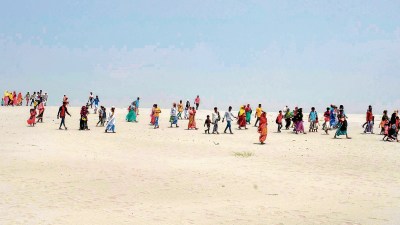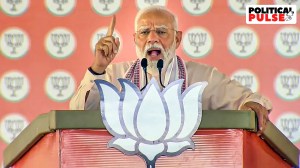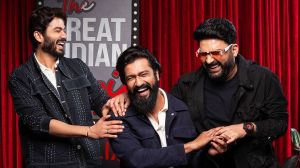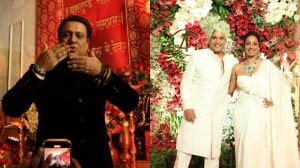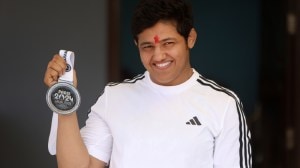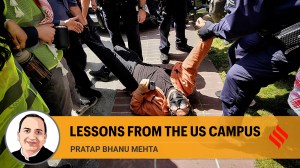- India
- International
An Expert Explains: Why US Election 2020 matters to India
US Election 2020: A look at how US-India relationship has evolved, and its highs and lows irrespective of whether the President has been a Democrat or a Republican.
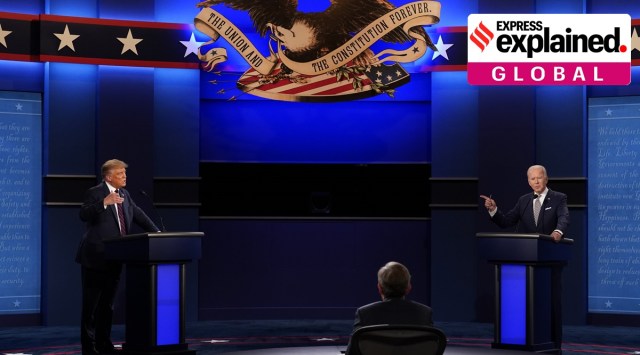 President Donald Trump, left, and Democratic presidential candidate former Vice President Joe Biden, right, with moderator Chris Wallace, center, of Fox News during the first presidential debate Tuesday, Sept. 29, 2020, at Case Western University and Cleveland Clinic, in Cleveland, Ohio. (AP Photo/Patrick Semansky)
President Donald Trump, left, and Democratic presidential candidate former Vice President Joe Biden, right, with moderator Chris Wallace, center, of Fox News during the first presidential debate Tuesday, Sept. 29, 2020, at Case Western University and Cleveland Clinic, in Cleveland, Ohio. (AP Photo/Patrick Semansky)The US relationship is the most important of India’s bilateral ties, having grown in recent years on account of China’s belligerence. In the concluding part of a series on the US Presidential election, a look at how this relationship has evolved, and its highs and lows irrespective of whether the President has been a Democrat or a Republican.
Why does the US Election 2020 matter to India?
The relationship with the United States of America matters to India more than any other bilateral engagement: economically, strategically and socially. American Presidents can often make a real difference to bilateral ties, including on trade, on immigration policies, and larger strategic issues.
Outside the fringes, the mainstream of political opinion favours stronger relations between the two countries. Anti-Americanism, once the knee-jerk reaction of the Indian elite, seems almost antediluvian today. The Indian diaspora in the US is one of the most successful expatriate communities, and while their political preferences may differ — they all favour a closer bonding between their janmabhoomi or pitrabhoomi and their karmabhoomi.
The reason for the drastic change in the geo-strategic outlook can be summarised quickly. India’s first serious departure from its Non Aligned posture, the 1971 Indo-Soviet treaty, was a response to the continuing US tilt towards Pakistan and the beginnings of a Washington-Beijing entente. In 2020, it is the frightening prospect of a powerful, belligerent and hegemonic China that has helped New Delhi build its relationship with Washington.
Will the outcome of the US election impact India-China ties?
Clearly, both Joe Biden and Donald Trump recognise the grave threat from China, but their response may be different. While Trump 2.0 may be willing to even more aggressively counter China, Biden is likely to follow a policy of “Congagement”: containment with engagement.

To be most effective, India’s China policy —many would argue — would have to be customised to the US’s response and coordinated with Washington. This has already generated, as it should, a robust debate.
A rising power like India has three clear strategic choices: Hedging; Balancing; or Bandwagoning.
A strategy of Hedging offers the prospects of continuing cooperation with China on areas of mutual interest, while building India’s defences and confronting Beijing on a la carte basis (at a time and place of new Delhi’s choice). A Biden Presidency may demand continued strategic Hedging.
Bandwagoning is a defeatist option of capitulation and accepting Chinese hegemony (“If you cannot beat them, join them!”). That would also exclude the US from the strategic options available; no self-respecting Indian would be comfortable with such an option.
An Expert Explains | What is at stake in the US presidential election on November 3?
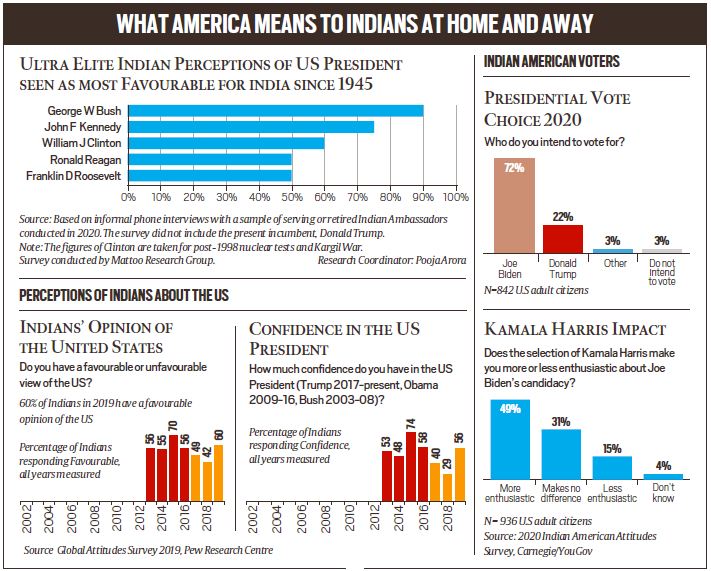 What America means to Indians at home and away
What America means to Indians at home and away
Balancing is the most challenging and confrontational option and is likely to be the preferred option of the Trump Presidency. India is not in a position to balance China on its own, and balancing (soft and hard: economic, diplomatic and military) would demand building a coalition with the US and other “like-minded” states.
What structure and form would balancing take? The shape of a “Quad” (with Australia, Japan and the US)? Or a full-fledged military alliance such as an Asian NATO? Would India be comfortable being a junior partner in such an arrangement? Where would it leave India’s deeply held belief in strategic autonomy, defined as the independence to make choices about war and peace?
There is a strong belief that Republican Presidents, historically, have been more pro-India than Democrats — is that true?
Other than anecdotal evidence and flaky intuition, there are few hard facts to support this contention. True, Republican regimes are often associated with the surgical pursuit of American interests, and can be less woolly-headed on issues like democracy, nuclear non-proliferation and human rights; but we have had Presidents, across the partisan divide, who have engaged India with passion and vigour.
Take the two Presidents often viewed as being the most affectionate towards India since World War II: John F Kennedy, in the 1960s, and George W Bush, in the 2000s. The former was a dyed-in-the-wool Democrat, and the latter a neo-Conservative Republican. Both reached out to India and engaged New Delhi with uncharacteristic zeal, in two very different times, but on both occasions the China threat acted as a catalyst to ensure that the bonding extended beyond just personal chemistry.
Recently declassified sources have revealed the extent to which Kennedy was willing to support India in positioning it as a democratic counterweight to a totalitarian China in Asia in the 1960s. The President sent one of his most trusted aides, the Harvard Professor John Kenneth (“Ken”) Galbraith as Ambassador; Ken had unfettered access to Prime Minister Jawaharlal Nehru and a hotline to the White House.
Also Read | US Election 2020: How and why Donald Trump vs Joe Biden affects the world
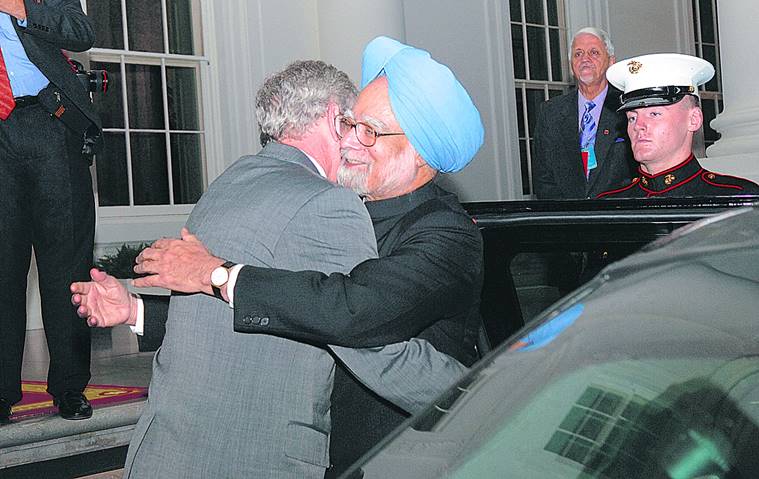 George W Bush with the then Prime Minister Manmohan Singh in 2008.
George W Bush with the then Prime Minister Manmohan Singh in 2008.
Later, the First Lady, Jacqueline (“Jackie) Bouvier Kennedy’s goodwill visit to India in March 1962 was not just a spectacular success, but built a deep bond between an ageing Nehru and the Camelot of brilliant minds that Kennedy had assembled (the previous 1961 Nehru visit to the US was surprisingly disappointing).
Jackie was put up in the “Edwina Mountbatten” suite at Teen Murti House, while in New Delhi, and according to former CIA analyst Bruce Reidel, Nehru was so smitten by Jackie that for the rest of his life, he had a picture of her on his bed stand. (Reidel‘s study JFK’s Forgotten Crisis: Tibet, the CIA, and the Sino-Indian War is easily the best account of those years.)
In 1959, Kennedy (as Senator) had given a major foreign policy speech (drafted by Galbraith, which one reads today with a sense of déjà vu). He said: “[n]o struggle in the world today deserves more of our time and attention than that which grips the attention of all Asia. That is the struggle between India and China for leadership of the East, and the respect of all of Asia…” A battle between a democratic India that supports “human dignity and individual freedom” against Red China which ruthlessly denies human rights. To help India win the race against China, Kennedy had proposed that there be an equivalent of a “Marshall Plan” for India funded by NATO allies and Japan, as it was the duty of the free world to ensure that democratic India prevailed over Red China.
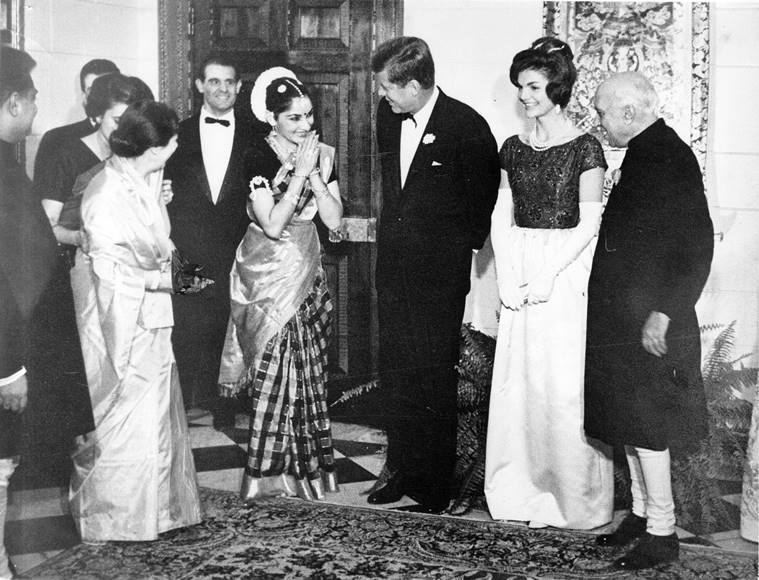 Kennedys meets Indian dancer as the then Prime Minister Pt Jawahar Lal Nehru looks on. Express archive photo
Kennedys meets Indian dancer as the then Prime Minister Pt Jawahar Lal Nehru looks on. Express archive photo
During the Kennedy years, India received unprecedented economic assistance, and in the 1962 war almost a carte blanche in terms of military aid (specifically requested by Nehru). Kennedy also played a role, according to Reidel, in restraining President Ayub Khan of Pakistan from opening a second front against India during the Sino-Indian war. More exceptionally, there were senior figures within the Kennedy administration who wanted India to be helped to test and develop nuclear weapons, before China did so, to give a psychological fillip to its standing in Asia.
Had Kennedy not been assassinated in 1963, and Nehru not died in 1964, the history of the US-India relationship may have taken a different course during the difficult 1960s and 1970s.
And then take the case of Bush, whose simplicity many compared to that of the fictional character Chancy Gardner — a simple-minded gardener thrust into the Presidency (played by Peter Sellers in the Hollywood film Being There). But his passion for India and his desire to arrive at a modus vivendi with New Delhi was driven by a zeal uncharacteristic of US Presidents. It even provoked the staid Prime Minister Manmohan Singh to become emotional in his final meeting with President Bush in September 2008.
In the Oval Office, Singh told Bush: “The people of India deeply love you. And all that you have done to bring our two countries closer to each other is something history will remember.” Indeed, the former Ambassador of the United States, the Harvard academic Robert Blackwill, used to often recount at his dinner roundtables at New Delhi’s Roosevelt House, an intriguing story about how he was persuaded to take up the job. In 2001, President Bush called him to his ranch in Texas and said: “Bob, imagine: India, a billion people, a democracy, 150 million Muslims and no al-Qaeda. Wow!”
Also Read | Under blue Silicon Valley skies, Indian-Americans find no algorithm can help choose between Biden and Trump
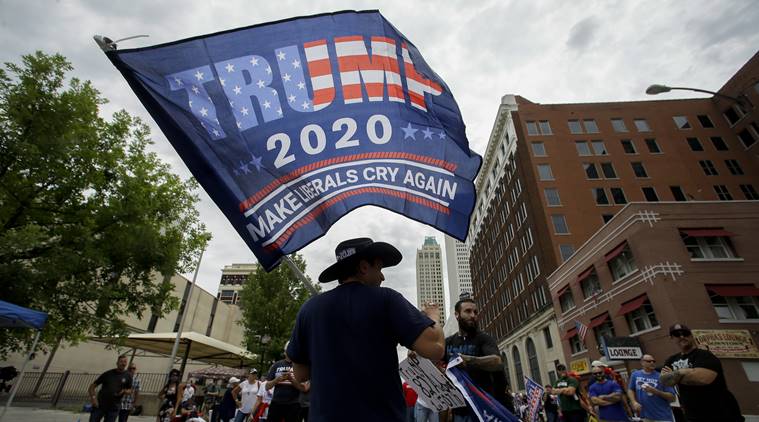 FILE – A supporter waves a flag prior to a campaign rally for President Trump at the BOK Center in Tulsa, Okla. (AP Photo/Charlie Riedel, File)
FILE – A supporter waves a flag prior to a campaign rally for President Trump at the BOK Center in Tulsa, Okla. (AP Photo/Charlie Riedel, File)
It was the personal weight that Bush put into it that ensured the success of the nuclear deal between India and the United States, despite the naysayers within the State Department. The agreement mainstreamed India’s nuclear programme. The deal was designed in a manner not to box India and its nuclear programme into a corner, but to welcome a rising power on to the high table of the management of the international system.
Similarly, the worst phase of India’s relations with the US was during the Republican Richard Nixon administration and the early years of the Democratic Bill Clinton administration. While the pro-Pakistan tilt of the Nixon Presidency in the 1970s is well known (especially since Islamabad was acting a conduit to Beijing in the new opening of the US towards China, the Princeton academic Garry Bass has recently unearthed that Nixon held deep prejudice against India and Indians.📣 Follow Express Explained on Telegram
During the early Clinton years of the 1990s, India and the US had a dip in bilateral relations; with pressure on India to “freeze, rollback and eliminate” its nuclear programme and to settle Kashmir. The presence of the impetuous Robin Raphael (an FOB — Friend of Bill) as Assistant Secretary aggravated the situation.
Before being elevated to that position, Raphael had been a counsellor in the American Embassy in New Delhi. In that position, she had been cultivated by Kashmiri separatists and the Pakistan High Commission, but treated with disdain by the Ministry of External Affairs (and deservedly so), including by Minister Hardeep Puri, then Joint Secretary for the Americas. Not surprisingly, in her very first off the record briefing, Raphael questioned Jammu and Kashmir’s accession to India and quickly helped US-India relations fall to a new nadir.
Fortunately, after the nuclear tests of 1998, the dialogue between Deputy Secretary Strobe Talbott and External Affairs Minister Jaswant Singh helped restore balance that led to a gradual warming of relations. In sum, there have been Democratic and Republican Presidents who have viewed India as a partner; and those, across the partisan divide, who have taken a less favourable view of India.
More Explained
EXPRESS OPINION
Apr 27: Latest News
- 01
- 02
- 03
- 04
- 05











